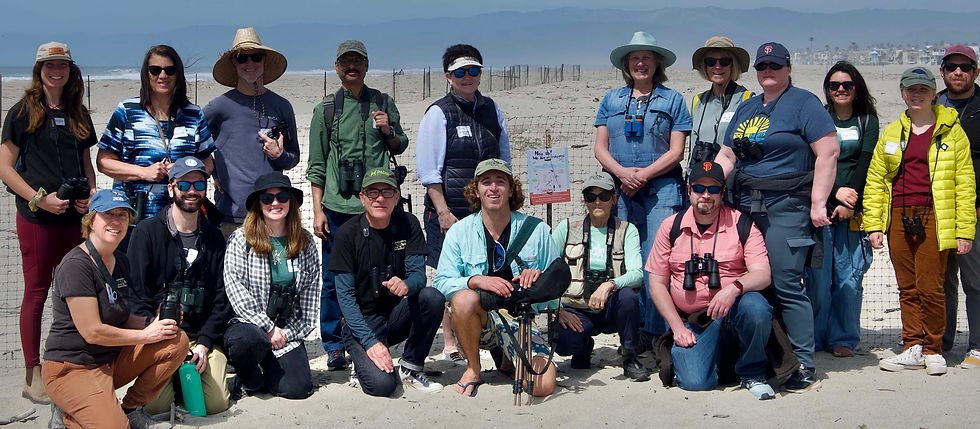2025 Ormond Beach Nesting Season Wrap
- Power to the Plover
- Sep 1
- 4 min read
Our biologists share real-time field updates from Ormond Beach, highlighting the nesting of snowy plovers and least terns throughout the season. Published Sept 1, 2025

Total # Nests | Hatch | Fail | Transferred to SB Zoo | |
Snowy Plover | 56 | 26 | 28 | 2 |
Least Tern | 28 | 5 | 23 | n/a |
Snowy Plovers
This year we documented 56 snowy plover nests. Out of those, 26 hatched (46.4%), 28 failed (50%), and 2 had to be transferred to the Santa Barbara Zoo for captive rearing.

The zoo chicks are doing well—one brood was released back to the wild just on August 15th (right), and the others have graduated to the outside flight pen and are expected to be released in late September. We’ll share more about this important program in a separate post.
Most exciting of all, we recorded about 18 fledglings at Ormond this season. Seeing young plovers survive to that stage is a real win.

Why Nests Failed
Our biologists determine nest outcomes by reading the signs left behind—plover tracks and the presence of tiny pip shells for hatches, or predator prints and crushed eggs for predation.
Predators were the main cause of nest failures — ravens (11 nests), skunks (7), a possum (1), and 3 nests taken by an unknown mammal. This means that of our failed nests, 73% are due to predators.
Human activity played a role too. 3 nests were lost directly to humans. 2 of them by egg theft and one was crushed when a bike was pushed over it.
Abandonment happened at 3 nests. Causes this year included infertile eggs, and one chick died just before hatching. A few others developed part way, but did not make it past the embryo stage. It is possible that in these cases egg abandonment was due to the adult plover being predated and the surviving mate abandoning the nest.
Two nests were rescued and transferred to the Santa Barbara Zoo before being lost. In both cases the nests were at risk of being lost due to human threats. One was established under a repeatedly knocked-down fence and another laid in a tire track near the tideline.

California Least Terns

Least terns are typically not numerous at Ormond Beach and nests that are established there do not do well, but they surprised us a little this year. We found 28 nests: and while only 5 hatched, it’s still an improvement from last year, when only one nest hatched and the chick survived just one week. But this year, at least four chicks survived to fledging, the first tern fledglings we’ve seen here in years.
The main threats to tern nests were ravens (7 nests), skunks (6), gulls (2 likely), humans (1), and several losses to unknown predators. Fourteen nests were built outside fenced areas, and those did especially poorly, only 2 of those hatched.

What stood out this season was the late timing. The last tern nest hatched on August 4th—after most terns would normally have already begun migrating. Our biologists found a fledgling from this late nest last week. And now least tern migration is finally underway and terns have left Ormond Beach on their fall migration.

Season Wrap-Up
The nesting season officially ends on September 6th, four weeks after the last snowy plover nest hatched (August 9th). That, too, was rather late this year.
Looking back, 2025 marks an improvement over 2024 in several ways:
Snowy plovers produced more fledglings this year than last.
Multiple least tern nests hatched chicks—and for the first time in many years, several survived to fledging.

This year reminded us how much is stacked against these birds, but also how resilient they are. Between the plover fledglings, the zoo chicks, and the rare success of fledged terns, there’s plenty to celebrate.
Thank You

This work is a collective effort. We extend our heartfelt gratitude to our volunteers and trained Beach Naturalists who dedicate long hours on the beach, our Shorebird Recovery Program staff for their unwavering dedication, and our partners and sponsors, including The Nature Conservancy and the California Coastal Conservancy, who supported us through an NCWC grant. We also thank the Western Foundation of Vertebrate Zoology for analyzing abandoned eggs and assessing their development status. Every helping hand improves the chances for these birds.
If you’re interested in helping protect Ormond Beach’s nesting birds, we’d love to hear from you. Contact our volunteer coordinator Kristen.





Comments